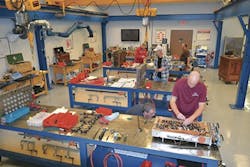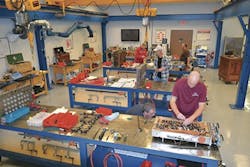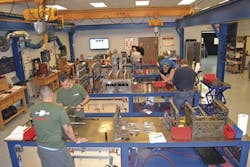Plant Design: Mold performance improved by well-designed toolroom
A well-designed toolroom is critical to maintaining the performance and readiness of injection molds.
"There are many considerations in tooling shop design that minimize mold maintenance time or allow the molder to make more-informed decisions to operate their toolroom better," said Steve Johnson, president of MoldTrax.
ASSESSMENT OF TOOLROOM DESIGN
MoldTrax helps molders improve efficiency by performing a maintenance capabilities assessment (MCA) of a company's toolroom and mold-maintenance infrastructure. By making adjustments based on the assessment, Johnson said a molder can reduce unscheduled mold downtime by as much as 50 percent, and mold maintenance labor hours by up to 10 percent.
"How the shop is set up plays a key role in its overall efficiency. Unfortunately, a toolroom is typically one of the last areas a molder thinks about when setting up a manufacturing operation; hence, its significance is often undervalued," Johnson said. Because of this oversight, many toolrooms are not optimized in terms of space or equipment layout.
As part of the MCA, Johnson calculates the mold pull pace (MPP), which is the level of traffic a toolroom will see in terms of mold-maintenance activity. The company can determine the number of pieces of specific equipment required for the toolroom based on the average number of molds coming into the room daily. By factoring in the spacing between each piece of equipment required to support the average workflow of molds, the molder can determine the overall size of toolroom required.
"Say I have five to 10 tools, each weighing about 6,000 pounds, coming through the toolroom for maintenance every 24 hours. I can determine the number and type of benches I need to handle that throughput and mold size, and the spacing between each workbench," Johnson said.
In one example, a molder organized a toolroom where 120 molds were pulled every 24 hours, based on the MPP. "We used MPP to determine the number of benches and stations for the toolroom and how to equip each station with tools for efficient mold maintenance or repair," Johnson said.
In another instance, MoldTrax worked with a client that spent about $250,000 for new equipment and a shop measuring 50 feet by 100 feet. Five standard-sized benches replaced four smaller benches, and were spaced 10 feet apart, to give mold makers plenty of room to work. Each of the new workstations was equipped with tool shadow boards. To improve efficiency, each workstation got its own overhead hoist and utility hookups, including fixtures for air and a water-testing system, as well as access to 110- and 220-volt power.
"We also lowered the height of two benches from 34 inches down to 25 inches to place the height of the large molds [10,000-15,000 pounds] in a more ergonomic position to work on," Johnson said.
The design has paid off for the shop, he said. "Shop productivity increased from three [preventive maintenance jobs] per day to eight, mainly because of the new organization level of the shop and the ability to get molds turned around quicker, more accurately and safer," said Johnson, who noted that technicians now spend less time looking for tools or waiting for an available hoist or hot-runner-manifold testing station.
SIX SIGMA DRIVES TOOLROOM DESIGN
Product workflow in the toolroom improves when the machinery layout is taken into consideration, said Todd Kuhn, a mechanical engineer with 25-plus years of experience. Although he currently is president of injection molding machinery company Bole North America, Scottsdale, Ariz., Kuhn also is a consultant on toolroom design. That includes advice on improving product workflow. His expertise was honed during his time as director of tooling and engineering with medical device molder West Pharmaceutical Services Inc., Exton, Pa.
"It is important to keep skill sets together, so group the hard machining equipment like mills and grinders and lathes on one side of the shop, and electrode manufacturing, EDM, sinker EDM and hole-popping operations in another area of the toolroom," said Kuhn, who has been in the tool and die business since 1988. "Optimizing product workflow layout in the toolroom minimizes unnecessary travel of the tool, cutting waste out of the process."
Kuhn's deep knowledge of toolroom design is combined with his focus on lean principles and methodology as a certified Lean Six Sigma Black Belt, as defined by the International Association of Six Sigma Certification LLC.
He said most tooling shops' hourly overhead costs range from $60 to $80, so they cannot afford to operate without lean principles in mind. Molders that consider upfront how to optimize equipment layout will benefit from being able to control these costs.
Some of the factors that are important in designing a clean room also are key in designing toolrooms; they include lighting, air temperature and humidity, Kuhn said.
A central air-conditioning system should also be considered for the toolroom. If there is a significant temperature difference from one end of the toolroom to the other, the dimensions of a tool moved through those areas could change a few thousandths of an inch, which could affect the accuracy of tool maintenance or setup, Kuhn said.
Imagining new ways to manufacture a part may result in the opportunity to eliminate a piece of equipment, freeing up space and impacting the design of the toolroom.
"There are many ways to manufacture tooling components. Imagine if you can eliminate the need for electrode manufacturing, going directly to hard milling or hard turning. This approach can save on electrode manufacturing and EDM time if one can use it."
He said molders should also design floors in the toolroom that can handle the weight of the machine, to minimize machine vibration during operation. All equipment should also be properly grounded within the toolroom, and the polishing and inspection department in a toolroom should be given its own space to ensure precise measurements.
Mikell Knights, senior staff reporter
Contact:
MoldTrax LLC,Ashland, Ohio, 419-281-0790, www.moldtrax.com


